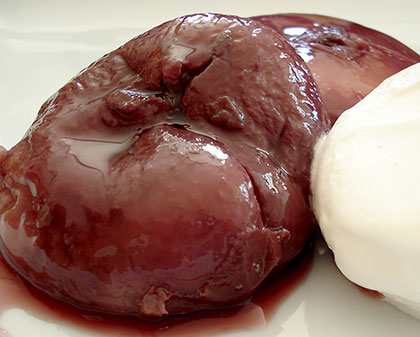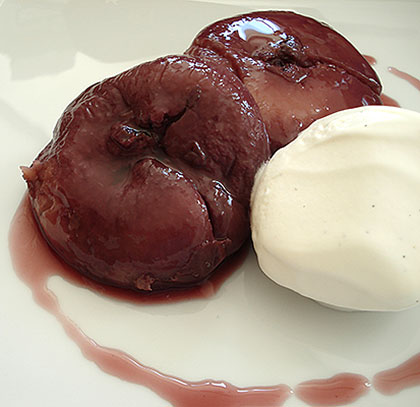Weekend project: Peaches poached in red wine
Summer is slowly drawing to a close. Sure it's mid-August, and the weather here has actually warmed up since the cold spell we had around the beginning of the month. But I can tell that summer is now an old lady because the taste of some produce is already changing. Peaches for instance. They were so sweet and juicy just a few days ago, but the ones I've bought the last few days are already either a bit too hard, a bit too sour, or rather mushy (showing they've been 'ripened' after being picked).
One of the best ways to deal with fruit that is just a bit off peak is to poach them in wine. Of course, fruit at their very peak can be poached too, and they will be absolutely luscious, and even fruit that's hard and unripe can be made edible.

This is a very basic method for poaching fruit, that should come in handy time and time again, but it's also rather time consuming, so I am suggesting this as a weekend project. You'll need to figure a total of 3 hours cooking time plus the time needed for cooling the fruit. The good thing is that it's quite effortless. Cooking it so slowly in a low temperature oven infuses the fruit with the wine as well as making it meltingly soft.
Note that I do not use any sugar in the recipe. If the fruit has enough natural sweetness, that should be quite enough. If the fruit you can get is very hard and sour though, you can add some sugar to the poaching liquid. See the notes below the recipe for more details.
The wine you use will also determine the sweetness. I prefer to use a dry red wine for poaching, since it adds a beautiful burgundy color as well as a slight tannic bitterness that makes it very adult. You can use any wine that you like however. A sweet dessert wine such as Vin Santo or an Eiswein may overwhelm the fruit a bit (besides, these wines are rather too expensive for me to anything other than sipping) but by all means experiment.
Peaches oven-poached in red wine

- 4 regular peaches, or 8 donut peaches, that are ripe but not in peak condition
- 1 1/2 cups (or more) of dry red wine (I used a Pinot Noir)
- 1 1/2 cups (or more, equal amount to the wine) of water
- Store-bought best quality vanilla ice cream, or your own homemade
Equipment needed: a non-reactive (enameled cast iron, glass, ceramic or stainless steel) casserole or pan with a tight fitting lid. Do not use an aluminum or uncoated iron container.
Preheat the oven to 120°C / 250°F.
Wash the peaches, and if using regular peaches cut them in half and pry out the stone (or leave it in, and scoop it out later). Donut peaches can be left whole. You do not need to peel them at this point. Place in the casserole or pan, cut side down.
Mix together the red wine and an equal amount of water, and pour over the peaches. The wine/water mixture should just cover the peaches, so use more if needed.
Put on the lid, and let cook in the oven for 1 1/2 hours. Take off the lid, and let it cook further for another 30 minutes.
Remove the peaches with a slotted spoon carefully and let cool. Put the pan back in the oven, lid off, and let cook further until the cooking liquid has reduced to about half, and is syrupy.
Cool the peaches and the syrup separately, well covered, in the refrigerator for several hours or overnight. The peaches will exude more liquid as it cools, but don't drain this off - just let the fruit sit in it.
To serve, carefully take off the peel. This is an optional process since the peel can be eaten, but it does look a bit better unpeeled. It should come off quite easily.
To serve, drain the peaches and place 2 halves (or 2 whole peaches if you used donut peaches) in a bowl or on a plate. Drizzle with the syrup. Add a scoop of vanilla ice cream.
Poaching other fruit
Soft stone fruit like nectarines, plums, and apricots can be poached in the same way as peaches. They don't need to be peeled at all - the peel will just soften and blend in. If you are unlucky enough to have some hard peaches, add a tablespoon of sugar for the whole batch to the poaching liquid. (Hard peaches are usually sweet enough after cooking like this.)
Naturally harder fruit like apples and pears should be peeled before poaching. Apple peel does add some flavor, so you might add the peel to the poaching liquid. Sour apples will need sugar - add 1 to 2 tablespoons per apple. Don't use this method for the really sour apples that are meant for cooking - use eating apples.
Pears also taste great with a cinnamon stick added to the poaching liquid.
If you enjoyed this article, please consider becoming my patron via Patreon. ^_^

 Welcome to Just Hungry, where we serve authentic Japanese recipes and more! I'm
Welcome to Just Hungry, where we serve authentic Japanese recipes and more! I'm 












Comments
Max
19 August, 2006 - 19:46
Permalink
Weekend project: Peaches poached in red wine
Normally, it is indeed so that a rather sturdy red wine is recommended for poaching fruit (well, mainly pears).
With the white wine, I think I would first try it with one of the naturally sweet grapes (such as Muscat), but not in the sweet version. Instead use the "dry" version of such wine (which itself is still pretty sweet and fruity).
Another thing worthwile to try would be using Port to poach the fruits (it does not need to be a Vintage quality...)